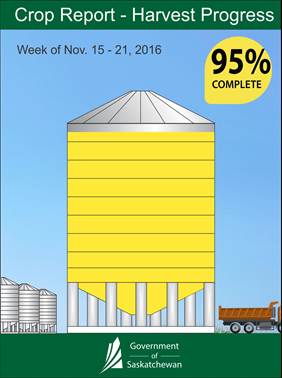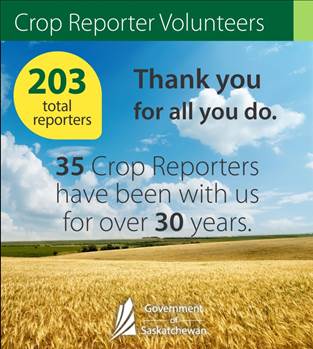Released on November 24, 2016
Despite many challenges this fall, Saskatchewan producers now have 95 per cent of the crop combined. Harvest continues in many parts of the province as weather and field conditions permit. Producers are hopeful that much of the remaining crop will be taken off prior to winter, although there are indications that some crop will likely be left out until the spring.Warm and relatively dry weather in early November allowed most producers to return to the field after cool and wet conditions halted harvest for much of October. While many producers have wrapped up harvest, some will need more time to take the crop off. In some areas of the province, water-logged roads and fields will have to freeze before they are able to support harvest equipment.
With only 89 per cent of the crop combined, the west-central region has the most crop remaining in the field. The northeastern region has 91 per cent of the crop combined; the northwest has 95 per cent; and the southeastern, southwestern and east-central regions each have 98 per cent combined.

The dry weather has reduced moisture levels in some crops, although most are still being harvested tough and damp. Aeration bins and grain dryers have been in continuous operation on many farms for well over a month.
Yields overall are well above average for the majority of crops but vary throughout the province. Yields for hard red spring wheat are reported as 45 bushels per acre, durum 48 bushels per acre, oats 92 bushels per acre, barley 69 bushels per acre, canola 40 bushels per acre, peas 42 bushels per acre and lentils 1,098 lb. per acre.
Quality is below average for almost all crops due to damage from insects, fusarium and other diseases, sprouting, staining and bleaching.
Average hay yields on dry land are reported as 1.6 tons per acre for alfalfa, 1.7 tons per acre for alfalfa/brome, 1.4 tons per acre for other tame hay, 1.2 tons per acre for wild hay and 2.2 tons per acre for greenfeed. On irrigated land, the estimated average hay yields are three tons per acre for alfalfa, four tons per acre for alfalfa/brome and 4.5 tons per acre for wild hay and greenfeed.

Hay quality going into winter is rated as 65 per cent good and 35 per cent fair. Cattle producers have indicated that they have adequate winter feed supplies.
The number of acres seeded to winter cereals is slightly below average. A late harvest, combined with wet fields, delayed fall seeding operations in much of the province.
Heading into winter, cropland topsoil moisture conditions are rated as 51 per cent surplus and 49 per cent adequate, while hay land and pasture topsoil moisture conditions are rated as 24 per cent surplus, 75 per cent adequate and one per cent short.
Farmers are busy trying to complete harvest, drying grain, finishing fall work and hauling grain. Neighbours are helping neighbours finish harvest.
A complete, printable version of Crop Report is available online at http://www.publications.gov.sk.ca/redirect.cfm?p=83360&i=95915.
Follow the 2016 Crop Report on Twitter at @SKAgriculture.
-30-
For more information, contact:
Shannon Friesen
Agriculture
Moose Jaw
Phone: 306-694-3592
Email: shannon.friesen@gov.sk.ca
